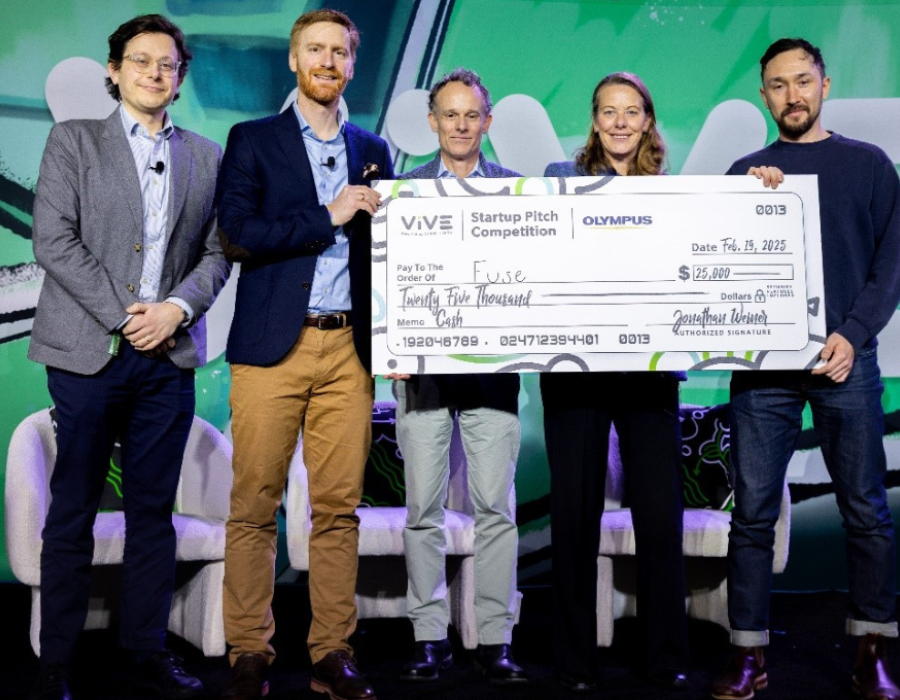
Exploring the Future of HealthTech at the 2025 ViVE Conference
By: Sue Scerbo, Sr. Manager, Public Relations and Communications for Olympus Corporation of the Americas
Health tech is a dynamic sector with fast-paced development. Olympus® Endoscopy Solutions Ecosystem (ESE) Strategy & Partnerships team members need to be on the lookout for the latest innovations in health tech as they support future digital solutions at Olympus.
Attending this year’s ViVE conference in Nashville, TN, gave Olympus ESE Strategy & Partnerships team members the birds-eye view of the health tech environment they need to drive digital innovation forward. Olympus ESE Strategy & Partnerships team members Benjamin Wilhelm, Yuta Ito, Igor Radovitskiy, and Nikki van Teijlingen Bakker made the most of their time on ground in Nashville to connect with potential healthcare IT partners, gather market insights, and build awareness of Olympus’ vision for its digital solutions.
This vision for digital solutions at Olympus is centered on shaping the future of healthcare technology in endoscopy with the development of smart connected care ecosystems that integrate hardware, software, services, and data. The intent of a connected care environment is to support early patient diagnoses and reduce healthcare provider burnout.

Presenting the check to ViVE Start-up Pitch Competition winner Sho Sugihara, Fuse Insights CEO & Co-Founder (far right), are (from left): Olympus ESE Strategy & Partnerships team members Igor Radovitskiy and Benjamin Wilhelm, Hashed Health CEO & Founder John Bass, and McKesson Ventures Partner Michelle Snyder.
The first of these systems to be launched by Olympus is the cloud-based OLYSENSE™ software platform with CADDIE™, designed to enhance clinical decision-making and operational efficiencies by providing real-time clinical decision support and optimizing equipment utilization in the GI procedure room.
Moderating the Start-Up Pitch Competition at ViVE
Taking a hands-on approach to the health tech environment is the best way to see what’s out there and to be seen by potential partners. The ViVE Start-up Pitch Competition gave Wilhelm and Radovitskiy a view of the current development landscape. As judges and moderators of the competition, which Olympus sponsored, Wilhelm and Radovitskiy witnessed next-generation healthcare solutions that are pushing beyond traditional health tech boundaries.
Judges evaluated 12 startups on their ability to address significant problems, their business models, scalability, and the strength of their founding teams. In a fast-paced, live session, teams had 2.5 minutes each to pitch, followed by 2.5 minutes of Q&A. Fuse Insight emerged as the winner for its insurance intake solution to accurately predict costs and eligibility for care prior to procedures (based on evaluations shared during the presentation session).
Other stand-out start-ups in the competition included a virtual reality surgical training system for urogynecology and an AI tool for predicting the risk of cancer metastasizing into bones.
5 Key HealthTech Challenges
After reflecting on his experience at the conference, Wilhelm, Senior Director for Endoscopy Ecosystem at Olympus Corporation, identified five challenges facing the health tech sector.*
- Hospitals Demand Clear ROI and Outcome-based AI Solutions: The AI hype cycle is over, and health systems now expect measurable impact. Selling AI-powered solutions requires a strong value proposition that ties clinical AI, workflow automation, and asset management directly to financial and operational benefits.
- Interoperability and Public Cloud Adoption Accelerating: Software integration services are expanding rapidly, and cloud-based infrastructure is becoming the default. Seamless interoperability will be key for software solutions to integrate with existing systems.
- Cybersecurity and Compliance Among Top Priorities: As digital health systems proliferate, so do cybersecurity threats and regulatory scrutiny. Health systems prioritize vendors with strong security postures.
- Ambient AI Transforming Clinical Workflows: Rapid innovations in ambient AI, which leverages technology and computing to detect, react to, and generate insights without direct human interaction, is driving change in the clinical environment. Partnerships can facilitate rapid go-to-market strategies in this evolving space.
- Differentiating Solutions in a Crowded HealthTech Market: Competition is fierce, and successful companies are integrating their solutions deeply into workflows. Moving beyond AI-powered diagnostics to embedding solutions into broader operational systems will be a key differentiator.
*These challenges are based on opinions expressed by the employees who attended the 2025 ViVE Conference and do not necessarily reflect the views of Olympus Corporation or its affiliates.
Olympus is positioned to play a central role in leading digital advancements in endoscopy for patients and clinicians. Integrating the insights from the ViVE conference will help the ESE Strategy & Partnerships team focus their efforts within a rapidly health tech industry.
As we build partnerships that push the boundaries of what’s possible in endoscopy and beyond, we are looking to speak with clinicians, technologists, and healthcare leaders working to bridge the gap between innovation and impact. If your work aligns with our mission to elevate care through digital innovation, let’s start a conversation.
Would you like to connect with a member of our digital innovation team? Fill out the form below and an Olympus representative will be in touch.
Read more about the importance of digital solutions for connected care in endoscopy:
A Connected Care Vision for Endoscopy Patients and Clinicians
CADDIE is not intended to replace a full patient evaluation, nor is it intended to be relied upon to make a primary interpretation of endoscopic procedures, medical diagnosis, or recommendations of treatment/course of action for patients. The CADDIE computer-assisted detection device is limited for use with standard white-light endoscopy imaging only.





